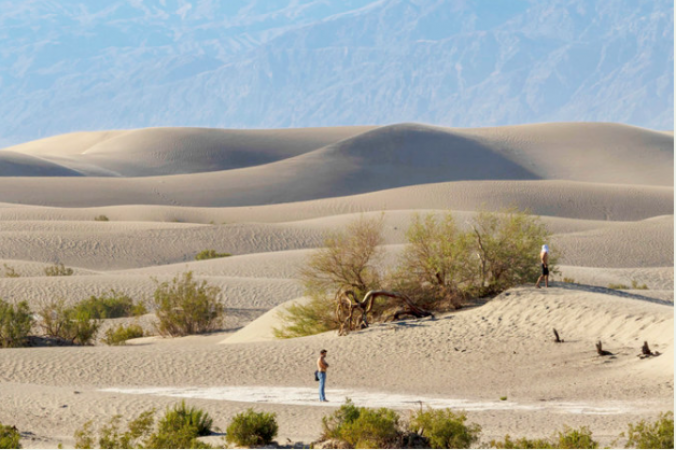
Death Valley: Death Valley National Park beckons, despite how uninviting it may sound. Tourists are flocking to this infamous desert landscape on the California-Nevada border even as the already extreme temperatures are predicted to rise even higher, possibly breaking records amid a major US heat wave.
After attempting a run in the oppressive heat earlier this week, Daniel Jusehus took a picture of a famous thermometer outside the appropriately named Furnace Creek Visitor Centre.
Jusehus, a visiting active runner from Germany, said, "I was really noticing, you know, I didn't feel so hot, but my body was working really hard to cool myself." He captured the temperature, which was 48.8 degrees Celsius or 120 degrees Fahrenheit.
Also Read: Arsenal Locks in Rising Star Jurrien Timber to Fortify Defense and Fuel Title Ambitions
Most visitors to the park, which bills itself as the lowest, hottest, and driest place on Earth, only travel a short distance to any site during this time of year before heading back to the cool comfort of an air-conditioned vehicle.
This weekend, the temperature may exceed 130 F (54.4 C), but some people who are willing to endure the heat probably won't be discouraged. Despite the fact that nighttime temperatures are still predicted to be over 90 F (32.2 C), warning signs at hiking trails caution against leaving the house after 10 a.m. According to the National Park Service, the highest temperature ever recorded in Death Valley was 134 F (56.6 C) in July 1913.
There have long been warnings for hikers in other parks. In the inner canyon of Arizona's Grand Canyon National Park, where temperatures can be 20 degrees hotter than the rim, officials are warning visitors to stay off the trails for the majority of the day.
Also Read: France celebrates Narendra Modi of India at Bastille Day extravaganza
Big Bend National Park near the Rio Grande is anticipated to be at least 110 F (43.3 C) in west Texas. It's best to avoid the trails in the afternoon, according to the National Weather Service.
Various parks and landscapes require different safety measures, according to Cynthia Hernandez, a park service spokesperson. If the situation becomes too dangerous, some trails may be closed. Websites for specific parks are where alerts and restrictions are posted, according to Hernandez.
According to preliminary data from the park service, at least four deaths in the 424 national park sites this year have been attributed to the heat. This includes a San Diego resident, 65, who was discovered dead in his car at Death Valley earlier this month, per a news release.
The emphasis in Death Valley National Park is on independence rather than relying on outside help. There is no guarantee that lost tourists will receive assistance in time, despite the fact that rangers patrol park roads and can help distressed drivers.
The desert park, which is located west of Las Vegas and spans a portion of the California-Nevada border, receives more than 1.1 million visitors each year. It is the largest national park in the Lower 48 with a total area of 5,346 square miles (13,848 square kilometres). In June, July, and August, about one-fifth of the visitors arrive.
Even after the advised cutoff times, many people are tempted to explore. The heat can become even more oppressive and exhausting during physical activity. After sunset, sun-baked soil, sand, and rocks are still radiating.
According to park ranger Nichole Andler, "it does feel like the sun has gone through your skin and is getting into your bones."
Others reported that the hot wind blowing through the valley was causing their eyes to dry out.
Also Read: IEA Lowers Oil Demand Forecast as Economic Headwinds Mount
It is very warm. Alessia Dempster, a visitor from Edinburgh, Scotland, said, "I mean, especially when there's a breeze, you would think that maybe that would give you some slight relief from the heat, but it just really does feel like an air blow dryer just going back in your face."
The park service's website describes Death Valley as a slender, 282-foot (86-meter) basin that is below sea level and surrounded by high, rocky mountain ranges. The sparse plant life and bone-dry air allow sunlight to heat the desert's surface. All of that heat is then released by the rocks and the soil and is eventually trapped in the valley's interior.
"Heat kills" and other messages are posted on the brownish hills of the park, including a Stovepipe Wells sign alerting people to the "Savage Summer Sun."
Nevertheless, there are a number of breathtaking locations that draw visitors. The salt flat-filled Badwater Basin is thought to be the lowest point in all of North America. Over 2,000 years ago, the 600-foot (183-meter) Ubehebe Crater was formed. The best place to see the sunrise is at Zabriskie Point.
Taiwanese visitor Eugen Chen praised the park as "beautiful" and a "iconic... very special place."
Josh Miller, an Indianapolis tourist who has already visited 20 national parks, agreed.
The scenery is amazing, but it's hot, he said.